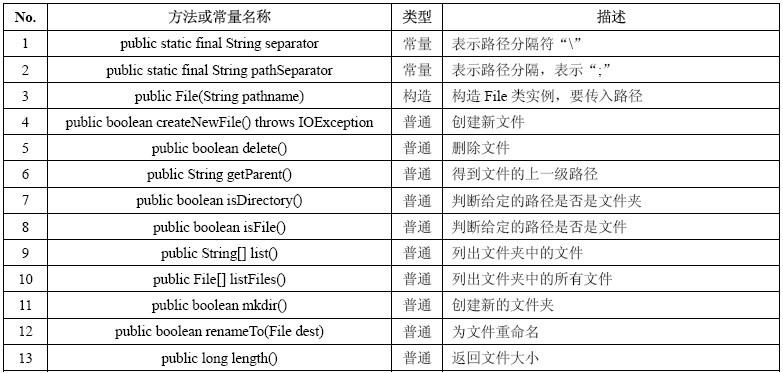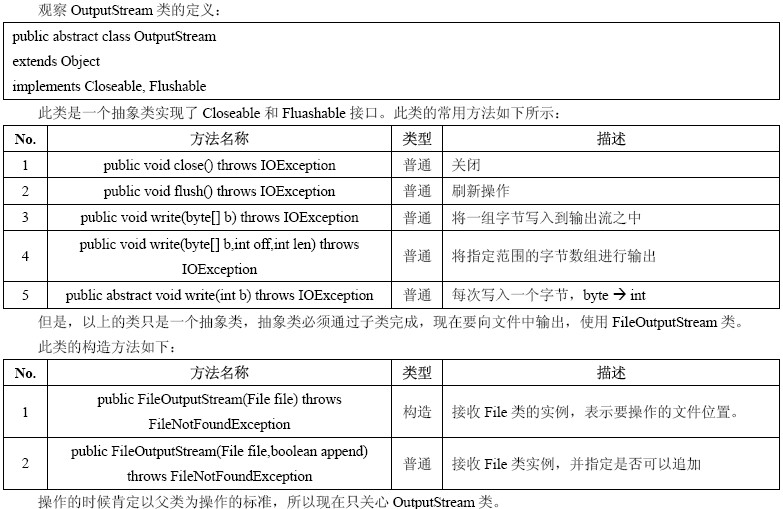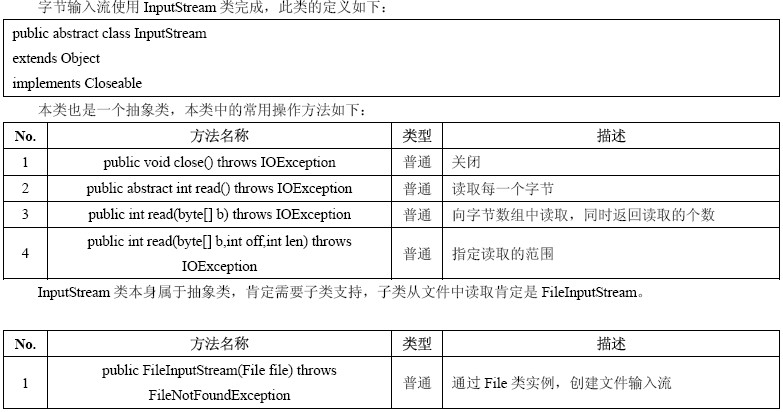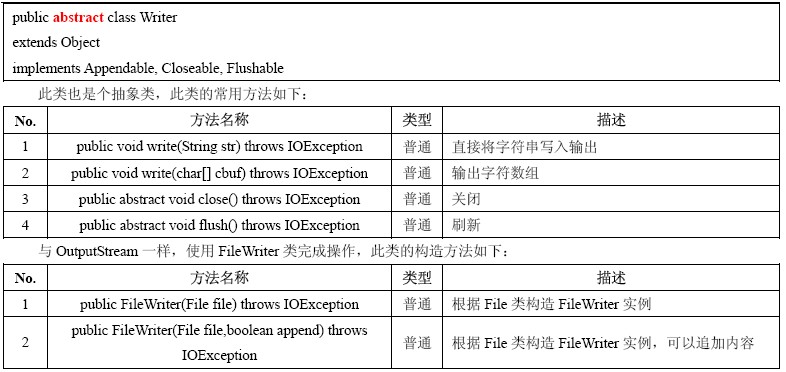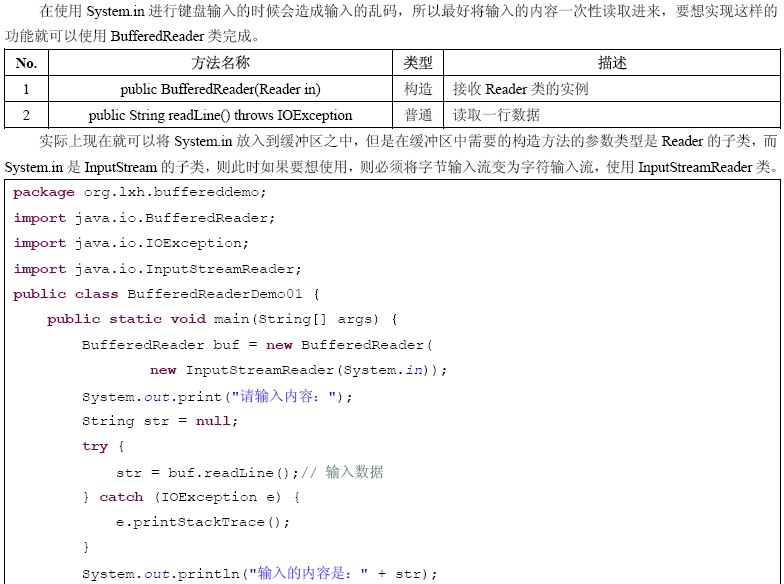java的IO类操作主要包括如下几类
(1)、File类的使用。
(2)、字节操作流:OutputStream、InputStream
(3)、字符操作流:Reader、Writer
(4)、对象序列化:serializable
1)File类
Java代码
[java] view plaincopyprint?
public class File extends Object implements Serizliable Comparable<File> 从定义看,File类是Object的直接子类,同时它继承了Comparable接口可以进行数组的排序。
File类的操作包括文件的创建、删除、重命名、得到路径、创建时间等,以下是文件操作常用的函数。
File类的操作:
(1)创建文件,注意File.separator可以解决跨操作系统的问题。
下面的例子是一创建一个文件,如果该文件存在则删除,否则创建该文件。
Java代码
public class FileDemo1 {
public static void main(String[] args) {
File file = new File("D:" + File.separator + "test.txt");
if (file.exists()) {
file.delete();
} else {
try {
file.createNewFile();
} catch (IOException e) {
// TODO Auto-generated catch block
e.printStackTrace();
}
}
}
} (2)文件的类型函数
file.isFile(); //判断是不是文件
file.isDirectory();//判断是不是目录
(3)列出目录的内容
pulbic String[] list();//列出所有文件名和目录名
public File[] listFiles();//列出所有文件和目录
2)、字节操作流(btyle)
(1)字节输出流OutputStream
Java代码
public class FileDemo1 {
public static void main(String[] args) {
File file = new File("D:" + File.separator + "test.txt");//指定要操作的文件
OutputStream out=null;//定义字节流输出对象
try {
//out= new FileOutputStream(file,true);//是否字节追加函数
out= new FileOutputStream(file);//获取实际的字节流输出对象,内容覆盖
} catch (FileNotFoundException e) {
e.printStackTrace();
}
String info="hello";//要输入的内容
byte[] b=info.getBytes();//将字符转化为字节数组
try {
out.write(b);
} catch (IOException e) {
e.printStackTrace();
}
try {
out.close();
} catch (IOException e) {
e.printStackTrace();
}
}
} (2)字节输入流InputStream
Java代码
public class FileDemo1 {
public static void main(String[] args) {
File file = new File("D:" + File.separator + "test.txt");//指定要操作的文件
InputStream In=null;//定义字节流输入对象
try {
//out= new FileOutputStream(file,true);//是否字节追加函数
In= new FileInputStream(file);//获取实际的字节流输入对象
} catch (FileNotFoundException e) {
e.printStackTrace();
}
int len=0;//输入数组长度
byte[] b=new byte[1024];//开辟空间,读取内容
//byte[] b=new byte[(int)file.length()];//根据文件大小开辟空间
try {
len=In.read(b);//读取
} catch (IOException e1) {
e1.printStackTrace();
}
try {
In.close();
} catch (IOException e) {
e.printStackTrace();
}
System.out.println(new String(b,0,len));
}
}(3)字符输出流Write
Java代码
public class FileDemo1 {
public static void main(String[] args) {
File file = new File("D:" + File.separator + "test.txt");// 指定要操作的文件
Writer write = null;// 定义字符输出流
try {
write = new FileWriter(file);
} catch (IOException e) {
e.printStackTrace();
}
String infor = "hello,heiehiehieh";
try {
write.write(infor);
} catch (IOException e) {
e.printStackTrace();
}
try {
write.close();
} catch (IOException e) {
e.printStackTrace();
}
}
} (4)字符输入流Reader
Java代码
public class FileDemo1 {
public static void main(String[] args) {
File file = new File("D:" + File.separator + "test.txt");// 指定要操作的文件
Reader read = null;// 定义字符输入流
try {
read = new FileReader(file);
} catch (IOException e) {
e.printStackTrace();
}
String infor = "hello,heiehiehieh";
char[] b=new char[1024];//设置字符的长度
try {
int len=read.read(b);
} catch (IOException e) {
e.printStackTrace();
}
try {
read.close();
} catch (IOException e) {
e.printStackTrace();
}
}
} (5)字节流和字符流的区别(重点)
字节流没有缓冲区,是直接输出的,而字符流是输出到缓冲区的。因此在输出时,字节流不调用colse()方法时,信息已经输出了,而字符流只有在调用close()方法关闭缓冲区时,信息才输出。要想字符流在未关闭时输出信息,则需要手动调用flush()方法。
(6)转换流:在io中还存在一类是转换流,将字节流转换为字符流,同时可以将字符流转化为字节流。
OutputStreamWriter(OutStream out):j将字节流以字符流输出。
InputStreamReader(InputStream in):将字节流以字符流输入。
(7)打印流 PrintStream
在操作中要求输出信息时,可以采用PrintStream进行输出,它包括PrintWrite和PrintReader
3)对象序列化
对象序列化是指将一个对象可以转化为二进制的byte流,可以以文件的方式进行保存。
将对象保存在文件的操作叫做对象的序列化操作。
将对象从文件中恢复的操作叫做反序列化操作。
一个对象如果要能序列化,它必须继承Serizliable。在实现序列化是则需要ObjectOurputStream完成,而需要反序列化时则采用ObjectInputStream。

transient关键字:变量声明为Transient后,该变量不可序列化。
4)内存流
在项目的开发过程中,有时希望只产生临时文件,将信息输出的内存中,此时会用到内存流,内存流基本方法如下:
Java代码
public class FileDemo1 {
public static void main(String[] args) {
String infor = "hello";
// 所有的内容向内存中输入
InputStream input = new ByteArrayInputStream(infor.getBytes());
// 所有内存的内容由outputStream输出
OutputStream out = new ByteArrayOutputStream();
int temp = 0;
try {
while ((temp = input.read()) != -1) {
char c = Character.toUpperCase((char) temp);
out.write(c);//从内存中输出,所有的内容都保存在ByteArrayOutputStream中
}
} catch (IOException e) {
e.printStackTrace();
}
try {
input.close();
} catch (IOException e) {
e.printStackTrace();
}
try {
out.close();
} catch (IOException e) {
e.printStackTrace();
}
System.out.println(out.toString());
}
} 5)System类对IO的支持
6)缓存读取
